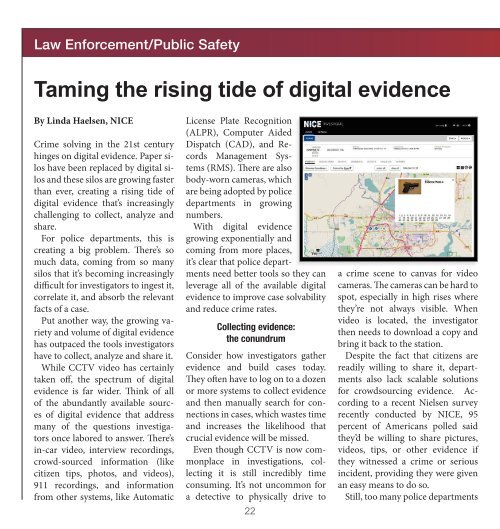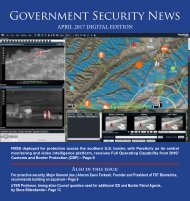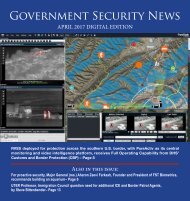GSN_Apr_FINAL+links
Create successful ePaper yourself
Turn your PDF publications into a flip-book with our unique Google optimized e-Paper software.
Law Enforcement/Public Safety<br />
Taming the rising tide of digital evidence<br />
By Linda Haelsen, NICE<br />
Crime solving in the 21st century<br />
hinges on digital evidence. Paper silos<br />
have been replaced by digital silos<br />
and these silos are growing faster<br />
than ever, creating a rising tide of<br />
digital evidence that’s increasingly<br />
challenging to collect, analyze and<br />
share.<br />
For police departments, this is<br />
creating a big problem. There’s so<br />
much data, coming from so many<br />
silos that it’s becoming increasingly<br />
difficult for investigators to ingest it,<br />
correlate it, and absorb the relevant<br />
facts of a case.<br />
Put another way, the growing variety<br />
and volume of digital evidence<br />
has outpaced the tools investigators<br />
have to collect, analyze and share it.<br />
While CCTV video has certainly<br />
taken off, the spectrum of digital<br />
evidence is far wider. Think of all<br />
of the abundantly available sources<br />
of digital evidence that address<br />
many of the questions investigators<br />
once labored to answer. There’s<br />
in-car video, interview recordings,<br />
crowd-sourced information (like<br />
citizen tips, photos, and videos),<br />
911 recordings, and information<br />
from other systems, like Automatic<br />
License Plate Recognition<br />
(ALPR), Computer Aided<br />
Dispatch (CAD), and Records<br />
Management Systems<br />
(RMS). There are also<br />
body-worn cameras, which<br />
are being adopted by police<br />
departments in growing<br />
numbers.<br />
With digital evidence<br />
growing exponentially and<br />
coming from more places,<br />
it’s clear that police departments<br />
need better tools so they can<br />
leverage all of the available digital<br />
evidence to improve case solvability<br />
and reduce crime rates.<br />
Collecting evidence:<br />
the conundrum<br />
Consider how investigators gather<br />
evidence and build cases today.<br />
They often have to log on to a dozen<br />
or more systems to collect evidence<br />
and then manually search for connections<br />
in cases, which wastes time<br />
and increases the likelihood that<br />
crucial evidence will be missed.<br />
Even though CCTV is now commonplace<br />
in investigations, collecting<br />
it is still incredibly time<br />
consuming. It’s not uncommon for<br />
a detective to physically drive to<br />
a crime scene to canvas for video<br />
cameras. The cameras can be hard to<br />
spot, especially in high rises where<br />
they’re not always visible. When<br />
video is located, the investigator<br />
then needs to download a copy and<br />
bring it back to the station.<br />
Despite the fact that citizens are<br />
readily willing to share it, departments<br />
also lack scalable solutions<br />
for crowdsourcing evidence. According<br />
to a recent Nielsen survey<br />
recently conducted by NICE, 95<br />
percent of Americans polled said<br />
they’d be willing to share pictures,<br />
videos, tips, or other evidence if<br />
they witnessed a crime or serious<br />
incident, providing they were given<br />
an easy means to do so.<br />
Still, too many police departments<br />
don’t provide an easy way for citizens<br />
to submit photos, video or tips.<br />
They don’t have the systems or the<br />
infrastructure to readily accept this<br />
evidence for everyday investigations,<br />
and especially for large-scale<br />
events.<br />
Investigators also waste incredible<br />
amounts of time emailing, phoning,<br />
filling out paperwork, even driving<br />
from place to place to manually<br />
collect digital evidence. All of<br />
this evidence is then painstakingly<br />
copied and saved on CDs, DVDs or<br />
USB drives, and added to paper case<br />
folders.<br />
How new digital investigation<br />
and evidence management<br />
technology can help<br />
New digital investigation and evidence<br />
management technology is<br />
now helping to break down these<br />
barriers by enabling police departments<br />
to seamlessly connect all of<br />
their digital silos through one application.<br />
The technology provides<br />
a one-stop shop for gathering evidence<br />
so investigators don’t have to<br />
waste time logging on to all of the<br />
individual systems to manually collect<br />
evidence to build their cases.<br />
In addition to simplifying access,<br />
the technology is able to search<br />
across all connected systems and<br />
recommend evidence that is potentially<br />
relevant to the case.<br />
Advanced content analytics make<br />
both structured and unstructured<br />
data sources searchable. This includes<br />
audio recordings, databases,<br />
narratives from CAD comments,<br />
incident reports, FI cards, reports,<br />
documents, and more. This means<br />
that investigators can uncover connections<br />
and generate new leads,<br />
which ultimately helps them solve<br />
cases faster.<br />
An investigator also has the ability<br />
to add key words to a search.<br />
Let’s say, for example, a witness in<br />
a homicide investigation said they<br />
saw a panel van with ‘Joe’s Plumbing’<br />
marked on the side, fleeing the<br />
scene. By adding ‘Joe’s Plumbing’<br />
to a key word search, all connected<br />
sources – from incident reports in<br />
the CAD system to tagged crime<br />
scene photos and witness statements<br />
– would be searched for those<br />
two key words.<br />
In addition to searching docu-<br />
22 23<br />
ments and databases, the technology<br />
can convert audio to text to<br />
make it searchable, so for example,<br />
911 calls and interview room recordings<br />
could be searched for the<br />
words ‘Joe’s Plumbing’ as well. All<br />
the investigator would need to do is<br />
review the suggested evidence, and<br />
select it to add it to a virtual case<br />
folder.<br />
Investigators can also initiate and<br />
track evidence requests using built<br />
in workflows, and receive automatic<br />
notifications when those requests<br />
are fulfilled. This makes it easier for<br />
an investigator to stay on top of active<br />
cases, while not losing track of<br />
evidence or leads.<br />
Furthermore, citizens can submit<br />
video, photos and tips through a secure<br />
public portal. Private businesses<br />
can also use the portal to register<br />
their CCTV cameras and provide<br />
contact details, making it easier for<br />
law enforcement agencies to crowdsource<br />
evidence. By geo-locating<br />
both city-owned and private CCTV<br />
cameras, the technology enables investigators<br />
to look at the area where<br />
a crime occurred and know where<br />
cameras are located, minimizing<br />
time spent canvassing for video.<br />
The technology is also cloudbased<br />
so it can scale to growing evidence<br />
storage requirements if there’s<br />
More on page 42















